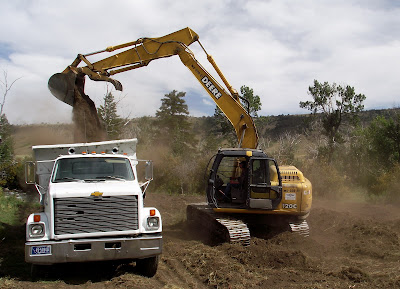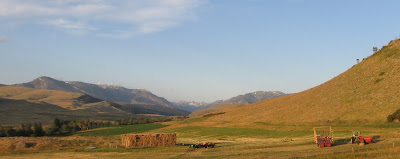It was mid-afternoon and Ted was making good progress at the stacking when the balewagon died.
Out of gas, he assumed. That rig really burns through the gas driving through the field picking bales, then hauling the 5-ton loads to the stack. There are two 40-gallon tanks, and Ted switched the valves to draw from the other tank. It took longer than usual, however, for the engine to catch and run.
He had only picked a few more bales when the rig ground to a halt again – but this time the electrical system was dead. I had just finished baling, so I jumped on the 4-wheeler and headed out into the field to help him figure out the problem.
We ran back to the shop for a voltmeter as I thought through the possible causes. I recalled that I had replaced a faulty circuit breaker a couple of years back, so that was the first place I looked.
Sure enough, that breaker was broke. It took only a minute to extricate. There was still plenty of time to get to the parts house before closing, and we needed a few groceries. I quickly changed my shirt and headed for town.
The new breaker was hanging on the shelf in the front of the store. The price was $3.49 – the cheapest repair we’d had all summer – so I took two. After I quick trip to the grocery store I headed back to the ranch, and made it in time for supper.
I wanted to be baling first thing in the morning, and there was plenty of stacking to be done, so I went out after supper to install the new breaker.
The job took only a few minutes, and power was restored. I jumped in the cab to fire up the engine, but it cranked and cranked without ever firing. We thought we had plenty of fuel in the other tank, but why wouldn’t the engine run now that the electrical problem was fixed?
I’d had enough fun for one day, so I left the balewagon in the field and headed for the shower. In the meantime I ran the sequence of events through my mind, looking for a new diagnosis.
I had hay to bale in the morning, but the stacking was important too. I ran some gas into the transfer tank, and picked up a new piece of fuel line to replace some that was getting pretty frayed. Perhaps that frayed piece was allowing air into the line so that the fuel pump wasn’t able to draw gas.
I pumped more gas into the empty tank and installed the new fuel line, then we cranked the engine again. The battery was getting pretty low, so we attached jumper cables to the pickup. Still no fire. Perhaps the fuel pump was bad.
I rolled underneath and opened a fitting – there was plenty of fuel pressure! We now had power to the electrical system and we had gas to the carburetor, but did we have spark to the plugs?
The “hood” over the engine in the balewagon is a table that accumulates 15 bales to tip up into the load rack. We needed to have the engine running to activate the hydraulics to raise that table. We were able to squeeze in far enough to reach the distributor, however, and checked the coil wire for spark as we spun the engine – only an occasional weak arc. Ah, here was the trouble.
All millennium rigs have electronic ignition. But this outfit was made in the 1970s when breaker points were standard. I had replaced the points with an electronic module a few years back, and still had the points in my spare parts stash. We made another trip to the shop.
To replace the ignition components we needed better access to the engine. We loaded up a couple of chains and a couple of come-alongs.
Back at the rig we attached our come-alongs at the corners of the load rack arch and the corners of the table covering the engine, and commenced cranking. We finally gained enough clearance to climb in and work.
It took only a few minutes to remove the electronic module and swap for the original points and condenser. The electronic module showed an obvious burn. A quick check - and we had spark! Perhaps it was a short in this module that had burned out the breaker I had replaced the evening before.
Back in the cab of the balewagon I turned the key, and the engine roared to life – as long as I kept the key turned to the start postion. As soon as I released the key to the run position the engine died again. We peered under the table to see if I had failed to connect a wire, but saw nothing obvious. We needed to get that table up out of the way for further trouble-shooting.
The balewagon had died coming downhill, and it was sitting in a precarious position. The last tier had tipped forward when the rig stalled, and was in danger of falling down. We only needed to run the engine long enough to pick up two more bales and turn back up hill, then we could raise the table, stabilize our load, and have a clear view of the engine. I knew it would be hard on the starting circuit, but I only need to have it run for a couple of minutes.
I kept one hand on the key and juggled levers and the steering wheel to pick up the bales and turn back uphill. But we had to stop and straighten some bales before tipping the table. When we tried to start the motor again the starter just whirred. We had fried the starter Bendix!
I had an old used-up machine from which I had been robbing parts – I knew that I had replaced the starter on that old balewagon not long before I had parked it. We made another trip to the shop.
The starters were easily accessible, and we soon had the swap complete. I found no loose wires, and determined that the short in the module must have burned the contacts in the ignition switch. I grabbed a coil of wire and a couple of alligator clips to make a jumper wire.
With the new starter in place and a “hot wire” connected to the battery we tried one more time. Success!!
It was now almost noon on Thursday and the balewagon had quit the middle of the afternoon before. I had made one trip to town and numerous trips between the shop and the field before we at last had the machine running. It had only cost $3.49 in cash, plus the fuel for the trip to town, but we had lost half a day of baling and most of a day of stacking.
We are nearly finished with the haying, and have only a couple of thousand bales to stack. The hot wire works well enough to get us through to the end. We replace the ignition switch later.
And thus went another day in the life of the Millennium Cowboy.











